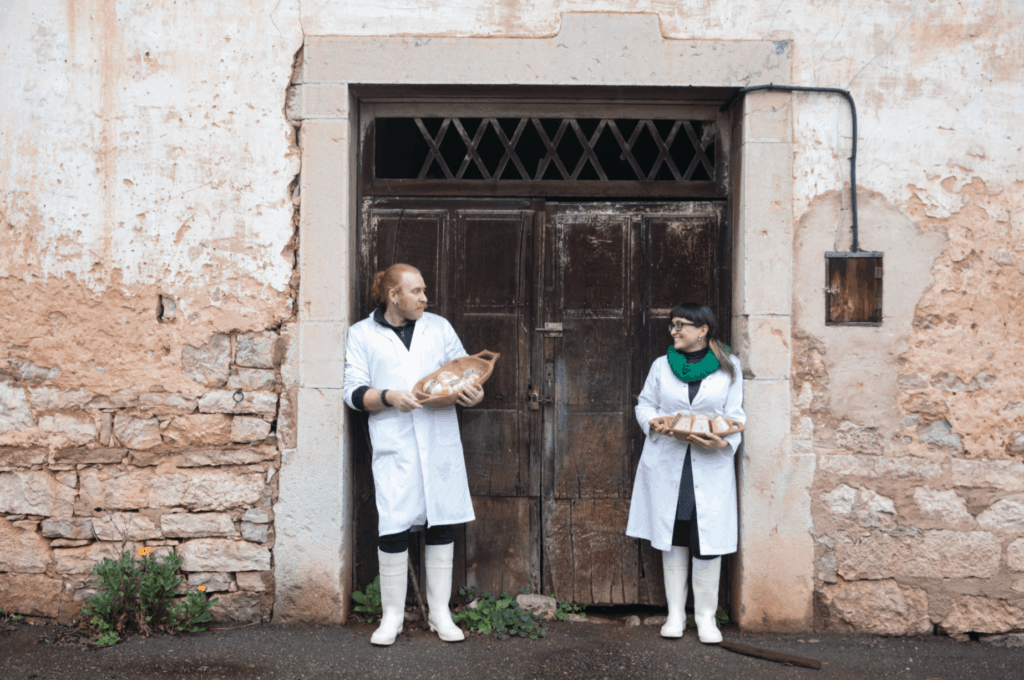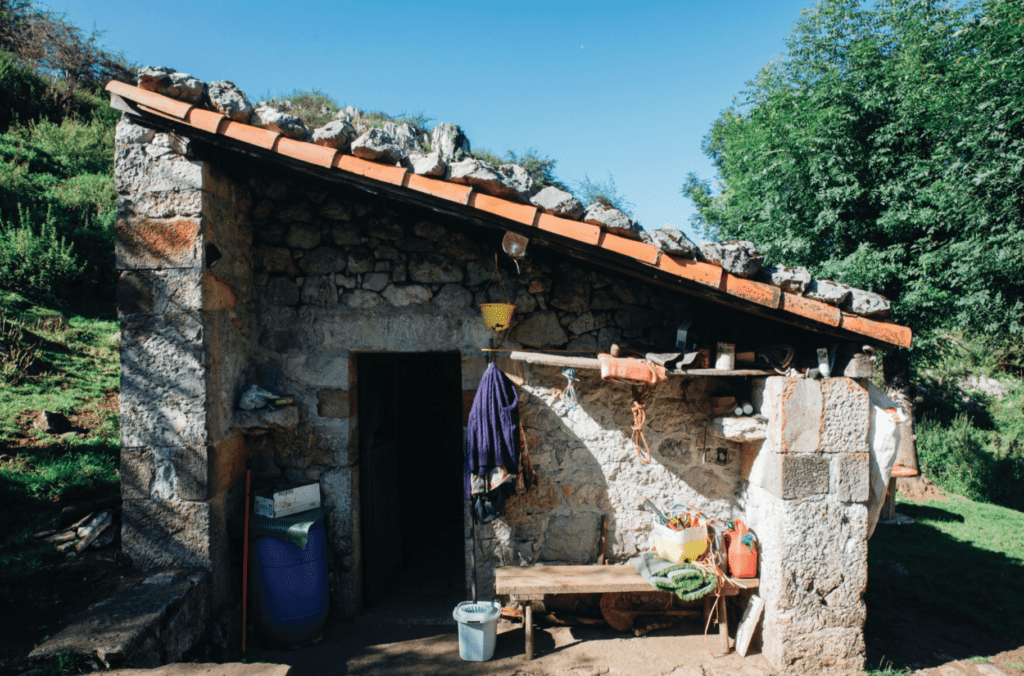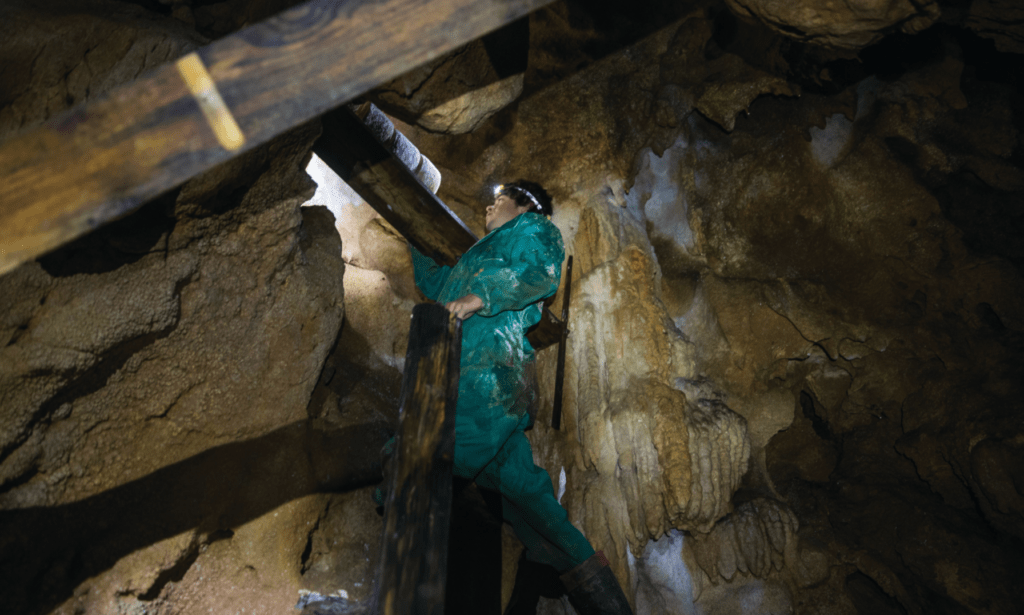
Breathe deeply and look around; aren’t we lucky to have this office!” says artisan cheesemaker José Luis Alonso. Surrounded by lusciously green pastures, glacial lakes, and imposing limestone peaks, his tiny hut, located in the majestic Picos de Europa, feels like the right place to get away from it all. Created in 1918, Picos—for short—is Spain’s first National Park, and the area is the birthplace of two of Asturias’s most renowned cheeses: Gamonéu and Cabrales.
Over forty different artisanal cheeses—four under Protected Designation of Origin (PDO)—are produced in Asturias, an impressive number considering the area is smaller than Connecticut. Part of “Green Spain,” the region’s soul is shrouded in Celtic mystique, and the landscape is as diverse as its cheeses: from coastal villages perched over the roaring Cantabrian Sea to remote mountain communities hidden within ancient woodlands. A third of its territory is environmentally protected.
Once, industrialization brought prosperity to the region. Today only vestiges of the former industrial past remain, and its remaining population is the oldest in the country. The young have been forced to look for job opportunities elsewhere, although the strong ties to the countryside have never faded away completely.
Cheesemaking in Asturias is an aging profession too. Nevertheless, a generation of young cheesemakers is bringing new life to the industry, incorporating modern approaches to the creation of ancestral cheeses. A few started from scratch, while for many others the art of cheesemaking is interwoven with their childhood memories. What many of these young cheesemakers have in common is the will to preserve their ties to the land and protect that heritage while building a way of life for themselves in the process.

Xel Díaz and Marta Fernández with their Afuega’l Pitu cheeses
MOUNTAIN PASTURES
Born and bred in eastern Asturias, Alonso cut his cheesemaking teeth with his grandparents. At his creamery, Uberdón, he makes Gamonéu del Puertu, an ancient cheese with a wild personality and an uncertain future, since there are only four artisan makers of the cheese left and half are nearing retirement age. Gamonéu is a ripe, crumbly, high fat, lightly smoked cheese made from a blend of unpasteurized cow’s, sheep’s, and goat’s milk—or mixtures of two of these three types of milk—with distinctive greenish-blue penicillium close to the edges. There are two types, both with PDO status: Gamonéu del Valle, made in the valley year-round, and the scarcer Gamonéu del Puertu, made in the high common pastures of Picos, where livestock roams freely during the warmer months.
Unsurprisingly, Alonso doesn’t have time to sit down for an interview; we talk as he labors. “I love my job, but I won’t lie, it’s hard work,” he says. To make his award-winning cheese, he tends 12 cows, 90 goats, and 260 sheep. Come the warmer weather, he moves—together with his animals—to the high mountain pastures, where he stays in his stone hut and makes cheese every day. “The challenge is to preserve this cheese and this tradition. I love it, and I don’t want it to disappear.”

Cheesemaker José Luis Alonso’s mountain hut
For centuries, these landscapes have been shaped by transhumance, a form of mobile livestock farming based on seasonal migrations exemplified by shepherds like Alonso and his free-roaming animals. Humble huts like his are dotted around the majadas, ancient clear spaces in the mountains. An added struggle for shepherds these days is the increasing presence of wolves in the area. It’s estimated that there were only a few hundred wolves in Spain in the 1960s, whereas now it is believed there are near 2,000, with over 90 percent of the population concentrated in the north. “I’m afraid our only chance to preserve this cheese is learning to co-exist with the wolves,” says Alonso. Recently, Spain’s government introduced a ban on hunting wolves in the rural north, where controlled hunting had still been allowed, and the move has provoked a huge debate.
SECRET CAVES
Some old traditions have been replaced by mechanical means; others, like the aging process, have been kept unaltered for centuries. Both Cabrales and Gamonéu cheeses are aged in the hundreds of natural limestone caves hidden in the area. The climate conditions inside the caves, including high humidity and cool temperatures, provide the proper environment for the cheeses to ripen while facilitating the appearance of the distinctive bluish-green mold that naturally occurs in both varieties.

Aging wheels of Arangas cheese
Since most caves are located in difficult-to-access areas, cheesemakers often have no other option but to carry their cumbersome wheels of cheese up to the caves on foot, sometimes helped by a horse, even if that means several trips ascending the rugged mountains on circuitous paths. The caves are located at different elevations and the wheels are left to ripen for different periods of time, which influences the final taste. Regular visits to turn, flip, and clean the cheeses are part of the demanding process required to produce them.
Sisters Ana and Elena Soberón, both in their 20s, make Cabrales, the region’s most well-known cheese and the first to obtain a European PDO in 1981. A pungent, blue-veined cheese with a strong aroma and a creamy, firm texture, it can be made solely from unpasteurized cow’s milk or blended with sheep’s and goat’s milk. Formerly, Cabrales cheese was wrapped in sycamore leaves, but now it is sold in aluminum foil. At their creamery, also called Soberón, Elena is the master cheese maker, while Ana tends the sisters’ 34 cows. “Until last year we also had sheep, but we had to sell them because of the wolves,” says Ana ruefully. The winding road that leads to their tiny hamlet of Arangas offers one striking view after another, spectacular limestone cliffs cut by narrow gorges and crystal-clear waters at the bottom.
The sisters have received awards for their sustainability credentials and now, on top of producing Cabrales cheese, are determined to revive an ultra-local cheese traditionally named Arangas, after their village. “I decided to start making cheese because it was a wonderful childhood memory I had, and I turned that memory into my way of earning a living, and above all, a way of life,” says Elena.

Gamonéu cheese aging in limestone caves.
Unlike Cabrales cheese, it’s virtually unknown outside their county, but their Arangas cheese has been a success. They started to produce it two years ago and are the only ones making it. This unique cheese is smoked before being taken to the caves to ripen, like Gamonéu. “We offer it as a whole wheel only, and it’s selling very well despite the price tag (it costs 45€/kg).” [about $27/lb.]
CENTRAL VALLEYS
Marta Fernández and Xel Díaz are the couple behind Ca Sanchu, a family-run creamery that produces PDO Afuega’l Pitu cheese. “My mother learned to make this cheese at age 15. When she married, she came back to it again, and she used togo to the Sunday market of Grau to sell them, as we do now,” explains Marta.
Made from cow’s milk, this versatile full-fat cheese is one of the oldest and more familiar in Asturias. Deeply ingrained in the local food culture, Afuega’l Pitu is native to the central-western valleys and mountains of the region, where the landscape conveys a serene beauty. Until three decades ago the cheese was mostly produced for self-consumption. There are two main varieties, Atroncáu, whose peculiar shape resembles an inverted flowerpot, and Trapu, which is ball-like and bundled up in a cloth tied at the top.
Their awareness about food miles means that Fernández and Díaz are just interested in selling their cheeses locally. In their tiny creamery, ladles are used to transfer the curds to perforated molds, the ancestral way. The flavor is slightly sharp, and the texture is smooth. There are white and red types, and the red cheese—which includes Spanish paprika—has a stronger, piquant flavor. “The challenge for Afuega’l Pitu in general is to get more people to appreciate it even at the local level, increase the distribution channels, and protect it,” says Marta, who concedes that reaching a wider clientele and exporting, even if they aren’t interested in the latter, are key to secure this variety’s survival.
BEECH AND OAKFORESTS
Indigenous to the area of Asturias that includes Redes Natural Park, a UNESCO Biosphere Reserve, PDO Casín cheese is made from unpasteurized cow’s milk. It’s often considered one of Europe’s oldest documented cheeses; there are written accounts of it dating back to the 14th century.

Stamping Casin cheese
After Francisco Cueria lost his job asa draftsman during the 2009 recession, he began making Casín, encouraged by his family and mentored by his late aunt María Luisa Cueria. La Corte, his creamery, has a large sliding glass door offering a view of the Tanes reservoir and the surrounding mountains. “What makes Casín cheese unique is the kneading during the production process,” Cueria says. Each producer can knead the curds as many times as desired to achieve their preferred texture; the more times it’s kneaded, the smoother the cheese will be, and the stronger the flavor.
From west to east, by the sea or up in the mountains, convivial fairs honoring local cheeses are celebrated year-round, particularly during the warmer months. Furthermore, the capital city of Oviedo will host the 2021 World Cheese Awards, as part of the Asturias Paraíso Natural International Cheese Festival in early November. Asturias’s local cheeses are often unavailable anywhere except in the counties where they are made, providing the best excuse to visit and also to enjoy the region’s striking landscapes.
If You Go…
EAT:
Creativity, respect, and sustainability are key aspects of chef Xune Andrade’s cooking. His Asturian cheesecake is a hit.
San Feliz, 33638
Asturias is the only location in the world where cider is poured from high above, a ritual that enhances the beverage’s taste. The award-winning Ovín sisters have mastered the art, and they run this traditional sidrería (cider house).
La Barraca, 16
33520. Nava
Cider in Asturias is a religion, and sidrerías are where life happens. Michelin-starred chef Jaime Uz’s newest venture offers a modern take on the concept.
Cervantes, 2. Villaviciosa
Casa Camacho
Teresa Camacho belongs to the “Guisanderas de Asturias” club, an association that enhances the work of women chefs. Hers is a simple menu that focuses on traditional Asturian fare.
Anieves, 28, 33919
Oviedo
The menu showcases chef Cristian’s love of Asturian cheeses: his mille feulle foie with Cabrales and his Gamonéu croquetas are must-tries.
San Juan de Parres, 37
Parres, 33550, Cangas de Onís
Located in the only wine-producing area of Asturias, this humble restaurant encapsulates the charm of another time and the menu always includes cheese-centric dishes.
Mayor 11,
33800 Cangas del Narcea
STAY:
Located at the foot of the Picos de Europa mountains, where some of Asturias’ better-known cheeses are made, this family run hotel takes sustainability very seriously and offers food workshops.
Collia, 33549
Arriondas
Located in Casín cheese country, in a setting of spectacular natural beauty, this 3-star rural hotel was founded by Marigel Álvarez, the woman who revived the cheese and first made it commercially available. The hotel sits next to her creamery, which is open to visitors.
Reciegos, El Llano, 18, 33990
Campo de Caso, Asturias




